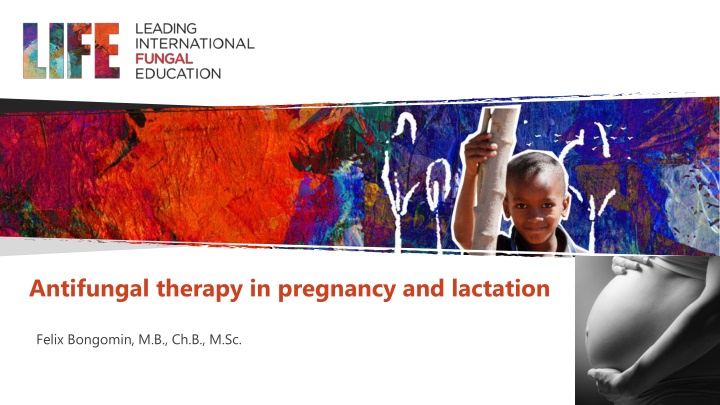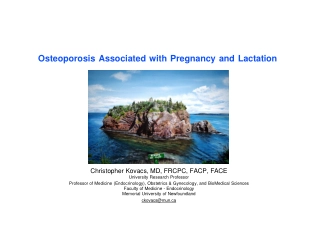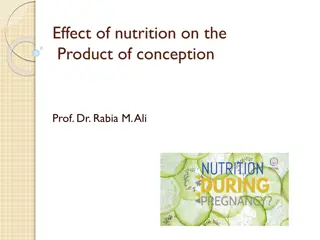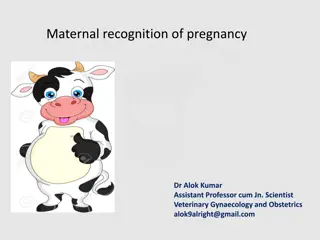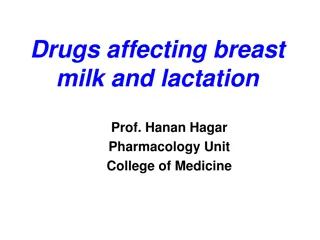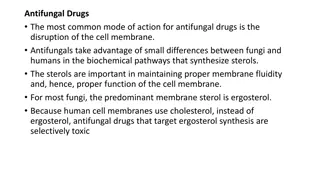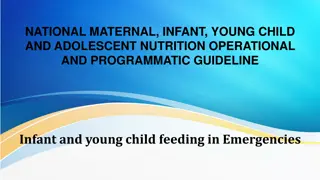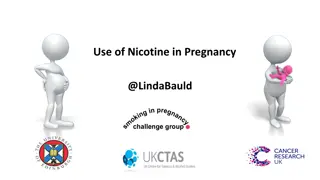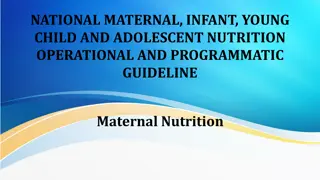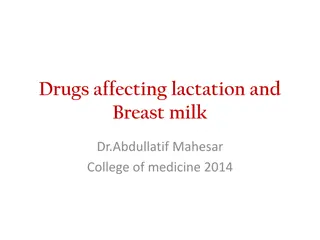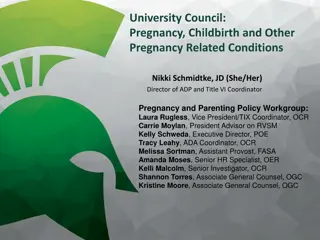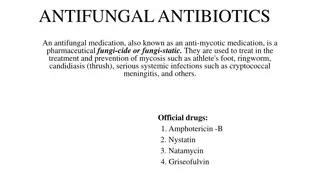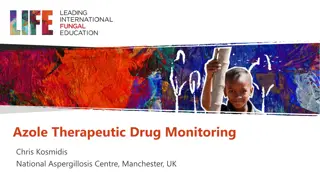Antifungal therapy in pregnancy and lactation
Pregnancy alters pharmacokinetics of antifungal agents due to changes in absorption, distribution, metabolism, and excretion. Understanding these changes is crucial for safe use of antifungals during pregnancy and lactation. This article discusses the physiological changes in pregnancy, fetal exposure risks, and how drug effects vary throughout gestation.
Download Presentation

Please find below an Image/Link to download the presentation.
The content on the website is provided AS IS for your information and personal use only. It may not be sold, licensed, or shared on other websites without obtaining consent from the author.If you encounter any issues during the download, it is possible that the publisher has removed the file from their server.
You are allowed to download the files provided on this website for personal or commercial use, subject to the condition that they are used lawfully. All files are the property of their respective owners.
The content on the website is provided AS IS for your information and personal use only. It may not be sold, licensed, or shared on other websites without obtaining consent from the author.
E N D
Presentation Transcript
Antifungal therapy in pregnancy and lactation Felix Bongomin, M.B., Ch.B., M.Sc.
Intended Learning outcomes To be able to recognise the complexity of treating fungal infections in pregnancy To understand the pharmacokinetic changes of antifungal agents in pregnancy To be aware of the teratogenic and/or embryotoxic effects of antifungals To be aware of the FDA risk categorisation of antifungal agents in pregnancy
General principles The great majority of drugs cross the placenta by simple diffusion from high to low concentration Molecular weight of the drug i.e. M.W. <1500 pass placental barrier by simple diffusion,e.g. All antifungals (Amphotericin B (924.1g/mol), Fluconazole (306.3g/mol) M.W. >1500 doesn t pass placental barrier e.g. Heparin. Molecules not bound to protein are available for transfer Molecules highly soluble in fat & in unionized state quickly pass to the fetus Molecules low solubility in fat & in an ionized state slowly pass to the fetus
Physiological changes during pregnancy in plasma volume in cardiac output in renal blood flow and GFR Altered liver enzyme activities 3A4 & 2C9 activity, 2C19 activity in plasma protein content Delayed gastric emptying William's Obstetrics, 24th edition
Resulting changes in pharmacokinetics ABSORPTION GI motility causes drug absorption DISTRIBUTION Protein binding causes free drug to be available in plasma volume causes volume of distribution with plasma concentration METABOLISM Hepatic metabolism occurs for some drugs EXCRETION Renal blood flow & GFR causes some drugs to clear the body faster.
The effect of a drug on the growing fetus Depends on:- 1. The dose absorbed by the mother 2. The period of gestation 3. Exposure time (duration of therapy) 4. Degradation products (metabolites)
The periods of gestation Pre-implantation 2 weeks post conception No teratogenicity (low dose) Spontaneous abortions After implantation 3-8 weeks (embryogenic period) Teratogenicity (congenital foetal malformations) 9-40 weeks (foetal period) Functional problems rather than gross anatomical anomalies Injury to foetal organs and placenta Learning and/or behavioural abnormalities
Early development Main embryonic period (weeks) Fetal period (weeks) 1 2 3 4 5 6 7 8 9 16 32 38 Neural tube defects Mental retardation CNS TA, ASD, and VSD Amelia/Meromelia Cleft lip Low-set malformed ears and deafness Microphthalmia, cataracts,glaucoma HEART LIMBS UPPER LIP EARS EYES TEETH PALATE GENITALIA Enamel hypoplasia Cleft palate Masculinsation EmbryoDeath Major congenital anomalies Functional & minor anomalies Highly sensitive period Less sensitive period Common site(s) of action
Maternal benefit vs. foetal risk assessment - Foetal loss - Congenital malformations - Organ toxicity - Prematurity - Learning / behavioural abnormalities Benefits
How do you prove that a drug is a teratogen? Three criteria must be met: I. Drug must cause a characteristic set of malformations. II. Exposure must be during a specific window of vulnerability (3-8 weeks) of gestation. III. The incidence of malformations should increase with increased dosage and duration of exposure Niebyl, J, Simpson, J, Glob. Libr. Women's Med.,(ISSN: 1756-2228) 2008
FDA Classification of Drugs Risk to Foetus Cat A Controlled studies of women failed to demonstrate a risk to the foetus in the 1st trimester (and there is no evidence of risk in later pregnancy) and the possibility of foetal harm appears remote Cat B Either animal studies have not demonstrated a foetal risk but there are no controlled studies in women, or animal studies have shown an adverse effect but this has not been confirmed in controlled studies in women Cat C Either studies in animal have shown an adverse foetal effect and there are no controlled studies in women or studies in women and animals are not available FDA: Federal Registry. 1980; 44: 37434 7.
FDA Classification of Drugs Risk to Fetus Cat D There is positive evidence of an adverse risk in the human foetus but the benefits from use in pregnant women may outweigh the risk Cat X Studies in animals or humans have demonstrated significant foetal abnormalities and the risk of the use of the drug in pregnant women clearly outweighs any potential benefit FDA: Federal Registry. 1980; 44: 37434 7.
Antifungals in pregnancy: Considerations Antifungal prescription remains a challenge in pregnant women Gross uncertainties regarding foetal toxicity of most antifungals Altered maternal pharmacokinetic parameters Affects efficacy or increase maternal and foetal toxicity Intrinsic activity of a given agent Drug-Drug interactions Pilmis et al. J Antimicrob Chemother. 2015; 70: 14 22.
Antifungal drugs and risk category in pregnancy Polyenes FDA category Amphotericin B B Nystatin* A King et al. Clin Infect Dis. 1998; 27:1151 60 Pilmis et al. J. Antimicrob Chemother. 2015; 70: 14 22 * Topical only
Antifungal drugs and risk category in pregnancy FDA category Azoles Ketoconazole C Fluconazole Low-dose regimen (150 mg/day) High-dose regimen (400 600 mg/day) C D Itraconazole C Voriconazole D Posaconazole C (No human data) Topical azoles C Pilmis et al. J Antimicrob Chemother. 2015; 70: 14 22
Antifungal drugs and risk category in pregnancy Echinocandins FDA category Caspofungin C# #No human data Micafungin C# Anidulafungin C# # no human data Pilmis et al. J Antimicrob Chemother. 2015; 70: 14 22
Antifungal drugs and risk category in pregnancy Other antifungals FDA category Flucytosine C Terbinafine B Griseofulvin C Cotrimoxazole D Pilmis. et al J Antimicrob Chemother. 2015; 70: 14 22
Teratogenic profile of antifungals Ketoconazole: Fluconazole: Itraconazole: Voriconazole: Posaconazole: Affects sex organ differentiation in the foetus (Animal studies) Craniofacial and rib abnormalities, and congenital heart diseases (Rodents & rabbits studies, case reports in humans). Low dose is safe Craniofacial and rib abnormalities (No evidence in clinical studies esp. in first trimester) Skeletal and visceral abnormalities (No evidence in clinical studies ) Skeletal malformations and rib abnormalities (No published human data) Sonino et al. N Eng J Med. 1987; 317: 812-8 Tiboni et al. Res Commun Chem Pathol Pharmacol. 1993; 79: 381 4. M lgaard-Nielsen et al. N Engl J Med. 2013;369:830-9
Teratogenic profile of antifungals Ossification and rib malformations Animal studies Caspofungin Visceral abnormalities and abortions Animal studies Micafungin Skeletal abnormalities Animal studies Anidulafungin Cancidas Package Insert. 2001. Cappelletty et al Pharmacotherapy 2007; 27: 369 88. Eraxis Package Insert. 2006.
Teratogenic profile of antifungals Bone and craniofacial malformations (reported from aborted foetuses) Only in first trimester, no evidence of adverse outcomes in second and third trimester (limited case reports) Flucytosine No teratogenicity in rodents or rabbits even in first trimester. Case reports in humans (No foetal abnormalities) Amphotericin B Neural tube defects (spina bifida), congenital heart diseases, cleft lips and palates, club foot Cotrimoxazole Pilmis. et al J Antimicrob Chemother. 2015; 70: 14 22
Conclusion Amphotericin B and its lipid derivatives are considered the cornerstone of treatment in any invasive fungal infection during pregnancy Fluconazole could be considered after the first trimester in the absence of an alternative agent. Effective contraception should be continued throughout treatment and for 2 months thereafter during itraconazole therapy Voriconazole is contraindicated in pregnancy Embryo-fetotoxic in rabbits, lack of human data Superficial infections during pregnancy require topical treatment, which can be prescribed throughout pregnancy, including topical azoles. Superficial fungal infections requiring systemic treatment, like dermatophytic onychomycosis, chromomycosis and mycetoma, should be treated after delivery.
